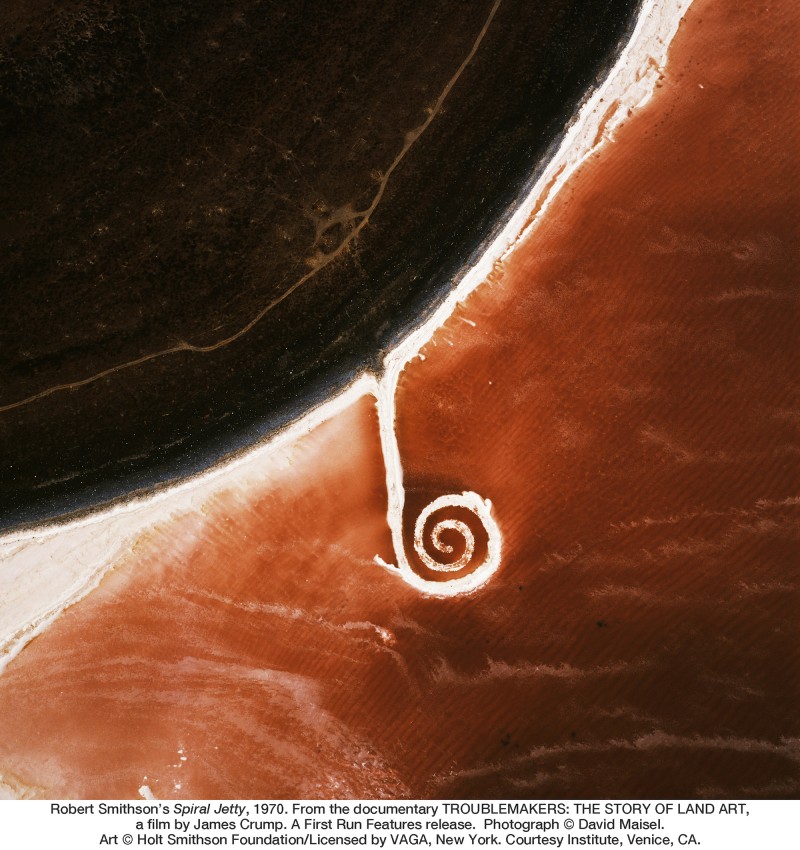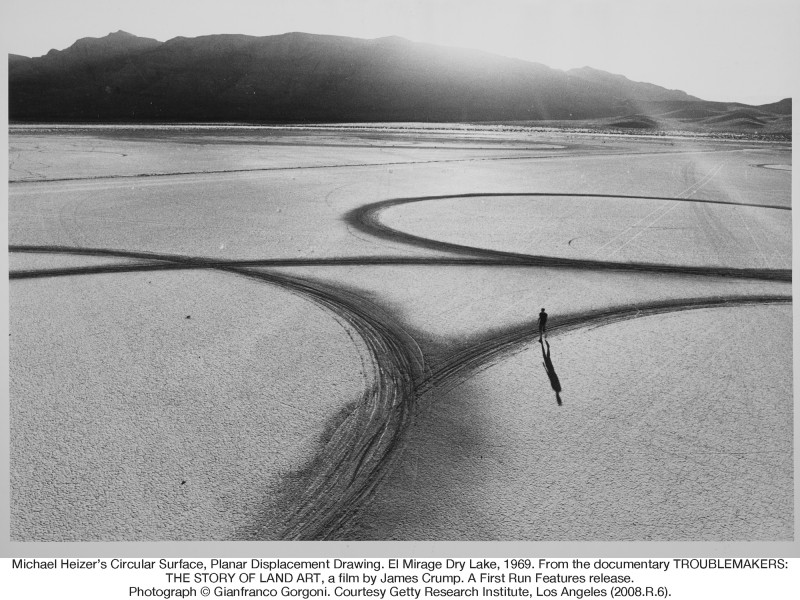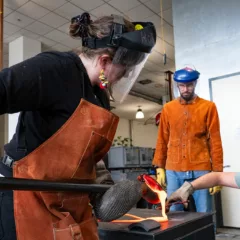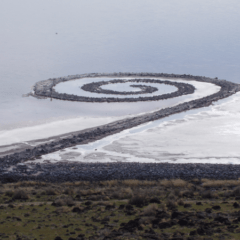“Troublemakers,” the documentary by James Crump opening at the IFC Center in New York on Jan. 8 and elsewhere around the country (although not in Philadelphia, sadly) shines a light on a brief period of time in the 1960s-70s when a few (mostly male) American artists made marks, gouges, and other interventions onto and into the land, mostly into the primordial and otherworldly lands of the American southwest. The movie is a loving look, with lots of archival footage and some contemporary interviews, at “Spiral Jetty” by Robert Smithson, “Double Negative” by Michael Heizer, and “Lightning Field” by Walter De Maria.
Earth art or land art was anti-gallery. But much of it was supported by a gallery, Dwan Gallery, and by Virginia Dwan (b. 1931), gallerist, and heir to the 3M fortune, who exhibited the artists’ small, gallery-sized pieces and helped support the creation of some of the massive earthworks by Smithson, Heizer and De Maria. Dwan organized the first Earth art show, “Earthworks” in 1968, at her gallery.
Dwan is featured prominently in the film, both in archival photographs, voiceover narration and in contemporary video footage. Her language is dispassionate but clearly she connected on a conceptual level with these artists who were not making profitable art for her gallery to sell but something else more spiritual and, ok, earthy.
Also featured at length and only in archival footage are the 3 artists, Smithson, Heizer and De Maria, two of them now dead, and the third (Heizer) very much alive and working, yet somehow not corralled for this movie. Contemporary peers of the earth artists, Vito Acconci, Carl Andre and Lawrence Weiner give voice to thoughts about the era, reminiscing today about the past.
The earth artists all seem like characters, macho, cowboy-ish and, in the case of Heizer, shamanistic. Smithson, the writer, was highly conceptual, and lauded for his writings. His works are concept-driven. De Maria seemed also concept driven but in a more mysterious way, since he didn’t say much. Heizer, who, in the black and white film footage, looks and acts like Stanley Kowalski in the desert — walking around bare-chested or in a white t-shirt, smoking a cigarette while shooting a gun — is a cypher, which is not to say he’s not also conceptual. At one point Heizer says something that makes you know he knew what he was about (paraphrasing): You cannot trade this thing, you can’t move it around…it’s an obligation.
I would have liked to know more about these artists. The movie dwells at the heart of their art and leaves their lives in shadows. We only know that Smithson was from New Jersey and was married to Nancy Holt, (whose art is dealt with late in the movie) also from New Jersey; De Maria was Italian and from the West Coast, and Heizer accompanied his father, the Berkeley archaeologist Dr. Robert Heizer, on archaeological digs. Each one of these artists could hold the stage for an entire movie, and maybe that will happen.
Land art wasn’t a movement but it spontaneously erupted in the thinking of young maverick artists. A product of its time, land art happened when NASA was beaming back photos of Earth that made us understand the planet was an actual object in space, able to be cut into, cracked open or drawn upon. Land art also happened during the politically charged era of the Vietnam War, the Civil Rights movement, feminism, and a general time of anti-establishmentarianism. And Land art happened when air travel was more generally available — thus, making a birds-eye view of huge art installations not only imaginary but real.
This is a movie with big aspirations to tell a story about these maverick artists and their literally big ideas. It covers a lot of territory (literally and figuratively) and has an enormous amount of gorgeous black and white footage and a brooding soundtrack like that of the British detective series, Broadchurch. (I wondered why.)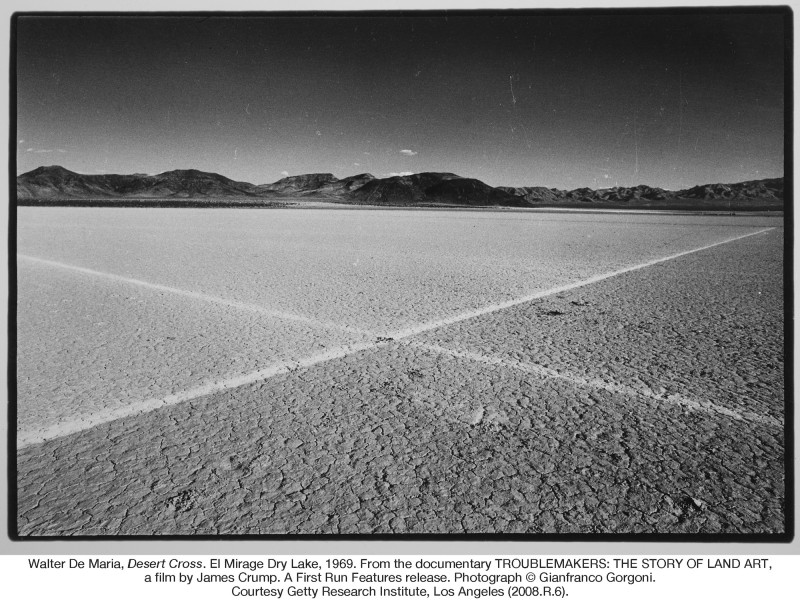
There’s a worshipful tone here, cool and clinical and a little mournful. And into all this, there is inserted an incredibly jarring moment — in color — film of the carpet bombing of Vietnamese villages and villagers running down roads after the bombings. This shocking visual material is backdrop to a discussion of the politics of the 1960s and 70s and what might have inspired the earth artists. The images are there no more than a few seconds but if they are there to make a point they made it with a hammer.
It’s left to Vito Acconci (b. 1940) a contemporary of the earth artists and a maverick in his own right to play Greek chorus and raise little nattering issues about Land art that don’t come up elsewhere. It’s from Vito that we hear…
How interested were these artists in people? They seem more interested in individual experience.
You (the viewer) have to risk your life to see it…
People make pilgrimages to Nevada to see it….is this a new kind of religion?
One of the less interesting aspects of the film revolves around Avalanche magazine and its founder Willoughby Sharp (1936-2008), an artist/writer/curator who organized an exhibit of Earth artists at Cornell University art museum in 1969, a year after Dwan’s show in New York. Sharp, whose mission was anti-gallery — he thought his magazine had the potential to replace the galleries — is a peevish character, incensed that his magazine didn’t get enough credit for championing this alternative art. I’m not sure the time spent on this historical but marginal figure helped contextualize the times or the art or helped the movie, which could have delved deeper into any one of the main figures and delivered more.
Among other things, and perhaps these are for another movie, I’d like to know what the role of DIA Art Foundation is in Land art — they have a big commitment to the works of Walter De Maria. How did they get involved? How about Gagosian Gallery, which shows (and sells) Michael Heizer‘s works today? And it would be nice to hear from Michael Govan, who championed Heizer’s works when he ran DIA and continues to do so as Director of LACMA. Clearly, earth art was important as a radical shift in thinking about what could be art. People in the art historical realm consider it important. There’s more to be said about why. And there should definitely be another movie. This one is a great start. Be sure to watch the trailer (above).
TROUBLEMAKERS: The Story of Land Art Documentary / 72 min / English / 2015 / Digital (DCP and Blu-ray)


